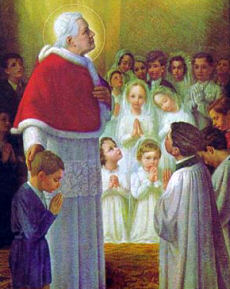
This day is especially for Saxon who will be taking Pius X as one of his Confirmation saints.
We will attend mass today and the children think wearing bare feet, no shoes required, would be fun as he took off his shoes to wear to school to save money.
A colouring page from Charlotte at Waltzing Matilda or tracing of one to be coloured in.
We will be having pumpkin soup(a humble dish) and bread for dinner.
Joseph Sarto was born in humble circumstances at Riese, a small village in Venetia, on June 2, 1835. He was successively curate, parish priest, bishop of Mantua, Patriarch of Venice — offices to which his keen intelligence, hard work and great piety caused him to be quickly promoted. He was elected Pope on August 4, 1903, and took the name of Pius X. As chief pastor of the Church he displayed untiring self-sacrifice and great energy; he was an intrepid defender of the purity of Christian doctrine. He realized to the full the value of the liturgy as the prayer of the Church and the solid basis that it furnishes for the devotion of Christian people; he worked for the restoration of the worship of the Church, especially plainchant, so that Christian people, as he put it, might find beauty in their public prayer. He spared no effort to propagate the practice, so great an aid to holiness, of early, frequent and daily communion. He died August 20, 1914 and was canonized on May 29, 1954.

St. Pius X
 The future Pope-Saint of the twentieth century was born at Riese in Venetia on June 2, 1835, his name, Joseph Sarto. After ordination at the age of twenty-three (by special dispensation), he labored for 17 years as a parish priest, then as bishop of Mantua, and in 1892 was advanced to the metropolitan see of Venice with the honorary title of patriarch. On August 4, 1903, he was elected Pope, "a man of God who knew the unhappiness of the world and the hardships of life, and in the greatness of his heart wanted to comfort everybody."
The future Pope-Saint of the twentieth century was born at Riese in Venetia on June 2, 1835, his name, Joseph Sarto. After ordination at the age of twenty-three (by special dispensation), he labored for 17 years as a parish priest, then as bishop of Mantua, and in 1892 was advanced to the metropolitan see of Venice with the honorary title of patriarch. On August 4, 1903, he was elected Pope, "a man of God who knew the unhappiness of the world and the hardships of life, and in the greatness of his heart wanted to comfort everybody."The primary aim of his pontificate Pius X announced in his first encyclical letter, viz., "to renew all things in Christ." Here we need but allude to his decree on early and frequent reception of holy Communion; his Motu Proprio on church music; his encouragement of daily Bible reading and the establishment of various Biblical institutes; his reorganization of the Roman ecclesiastical offices; his work on the codification of Canon Law; his incisive stand against Modernism, that "synthesis of all heresies." All these were means toward the realization of his main objective of renewing all things in Christ.
The outbreak of the first World War, practically on the date of the eleventh anniversary of his election to the See of Peter, was the blow that occasioned his death. Bronchitis developed within a few days, and on August 20, 1914, Pius X succumbed to "the last affliction that the Lord will visit on me." He had said in his will, "I was born poor, I have lived poor, I wish to die poor" — and no one questioned the truth of his words. His sanctity and his power to work miracles had already been recognized. Pius X was the first Pope canonized since St. Pius V in 1672.

"He was one of those chosen few men whose personality is irresistible. Everyone was moved by his simplicity and his angelic kindness. Yet it was something more that carried him into all hearts: and that `something' is best defined by saying that all who were ever admitted to his presence had a deep conviction of being face to face with a saint" (Baron von Pastor).
Excerpted from The Church's Year of Grace, Pius Parsch.
Patron: Archdiocese of Atlanta, Georgia; diocese of Des Moines, Iowa: first communicants; diocese of Great Falls-Billings, Montana; pilgrims; diocese of Springfield-Cape Girardeau, Missouri.
 Here is some more information for those who wish in depth information
Here is some more information for those who wish in depth informationBlessings,


1 comment:
No shoes huh!! ;)
Post a Comment